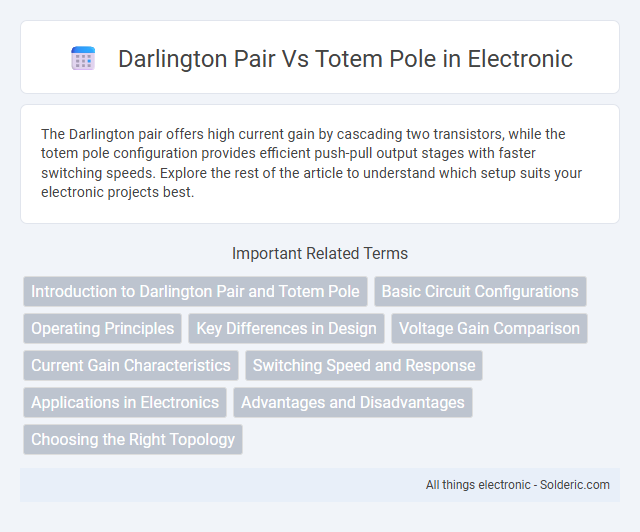The Darlington pair offers high current gain by cascading two transistors, while the totem pole configuration provides efficient push-pull output stages with faster switching speeds. Explore the rest of the article to understand which setup suits your electronic projects best.
Comparison Table
| Feature | Darlington Pair | Totem Pole |
|---|---|---|
| Configuration | Two transistors connected in cascade to increase current gain | Two complementary transistors stacked vertically for push-pull output |
| Current Gain (b) | Very high (~b1 x b2) | Moderate, depends on transistor specs |
| Output Stage | Saturated transistor output with voltage drop (~1.2V) | Push-pull output with near full voltage swing |
| Switching Speed | Slower due to stacked base-emitter junctions and storage time | Faster switching, suitable for digital and switching applications |
| Voltage Drop | Higher voltage drop (1.2V to 1.4V typical) | Lower voltage drop, close to 0V saturation |
| Applications | Current amplification in linear amplifiers, high gain stages | Output stage drivers, push-pull amplifiers, digital outputs |
| Complexity | Simple two-transistor design | More complex arrangement with complementary transistors |
| Power Efficiency | Less efficient due to voltage drop and saturation losses | More efficient due to push-pull operation reducing losses |
Introduction to Darlington Pair and Totem Pole
Darlington pairs consist of two bipolar junction transistors connected to provide high current gain, commonly used in amplifiers and switching circuits for enhanced performance. Totem pole configurations involve transistors arranged vertically to enable both sourcing and sinking current, improving output drive capability and speed in digital circuits. Understanding these configurations helps optimize your circuit design for either high gain or efficient switching.
Basic Circuit Configurations
The Darlington pair configuration consists of two bipolar transistors connected to provide high current gain by cascading one transistor's output into the base of the second, ideal for amplifying weak signals. The totem pole arrangement uses two transistors stacked vertically, typically NPN and PNP, to allow symmetrical push-pull output, enabling efficient switching and low distortion in digital and amplifier circuits. Your choice depends on whether you need high current amplification with the Darlington pair or fast switching with the totem pole configuration.
Operating Principles
A Darlington pair operates by connecting two bipolar junction transistors (BJTs) in a configuration where the current amplified by the first transistor is further amplified by the second, resulting in a high current gain. The totem pole configuration arranges transistors in a push-pull setup, with complementary transistors switching alternately to provide low output impedance and fast switching speeds. While the Darlington pair emphasizes high gain and simplicity, the totem pole focuses on efficient switching and output drive capability in digital and power applications.
Key Differences in Design
The Darlington pair consists of two transistors connected to provide high current gain by amplifying the input signal through a cascaded transistor arrangement. The totem pole configuration uses two transistors stacked vertically to provide both sourcing and sinking capabilities, enabling faster switching speeds and improved output drive. Key design differences include the Darlington pair's higher voltage drop and slower switching speed versus the totem pole's lower voltage drop and enhanced switching efficiency.
Voltage Gain Comparison
Darlington pairs provide high voltage gain by combining the gain of two transistors in a single package, typically reaching values above 1000, which is ideal for amplifying weak signals. Totem pole configurations prioritize current drive and switching speed over voltage gain, generally offering lower voltage gain compared to Darlington pairs. Understanding your circuit's voltage gain requirements will help determine whether a Darlington pair or a totem pole arrangement best suits your application.
Current Gain Characteristics
Darlington pairs provide significantly higher current gain due to the cascading of two transistors, which multiply the input current gain and result in gains typically ranging from 1000 to 10,000. Totem pole configurations, however, prioritize switching speed and output drive rather than extreme current gain, with gains generally lower than Darlington pairs but offering better performance in fast switching applications. Understanding your required current gain and switching speed will help determine whether a Darlington pair or a totem pole stage best suits your circuit design needs.
Switching Speed and Response
Darlington pairs exhibit slower switching speed due to their higher saturation voltage and increased charge storage from dual transistor stages, limiting high-frequency switching applications. Totem pole configurations enable faster response times by utilizing complementary transistor pairs that reduce switching losses and enhance signal transition sharpness. This makes totem poles more suitable for circuits demanding rapid switching and efficient performance at elevated frequencies.
Applications in Electronics
Darlington pairs are widely used in applications requiring high current gain, such as in audio amplifiers, switching circuits, and motor drivers, where they amplify weak signals to drive larger loads. Totem pole configurations are primarily employed in digital logic circuits and push-pull amplifier stages to provide fast switching and low output impedance for efficient signal driving. Both configurations optimize transistor performance but are chosen based on the need for gain versus switching speed in electronic applications.
Advantages and Disadvantages
Darlington pairs offer high current gain and simplicity in driving loads but suffer from increased voltage drop and slower switching speeds, impacting efficiency in high-frequency applications. Totem pole configurations provide faster switching and lower voltage drop, enhancing power efficiency and response time, but they require more complex circuitry and careful design to avoid cross-conduction. Understanding the trade-offs helps you choose the optimal design for your specific amplifier or switching needs.
Choosing the Right Topology
Choosing the right transistor output stage topology depends on the application's voltage, current requirements, and switching speed. The Darlington pair offers high current gain with simpler drive circuits, making it ideal for low-frequency, high-current amplifications. Totem pole configurations provide faster switching speeds and improved efficiency in digital circuits by minimizing saturation voltage and power loss.
darlington pair vs totem pole Infographic

 solderic.com
solderic.com